The AMD Radeon R9 Nano Review: The Power of Size
by Ryan Smith on September 10, 2015 8:00 AM ESTCompute
Shifting gears, we have our look at compute performance.
Starting us off for our look at compute is LuxMark3.0, the latest version of the official benchmark of LuxRender 2.0. LuxRender’s GPU-accelerated rendering mode is an OpenCL based ray tracer that forms a part of the larger LuxRender suite. Ray tracing has become a stronghold for GPUs in recent years as ray tracing maps well to GPU pipelines, allowing artists to render scenes much more quickly than with CPUs alone.
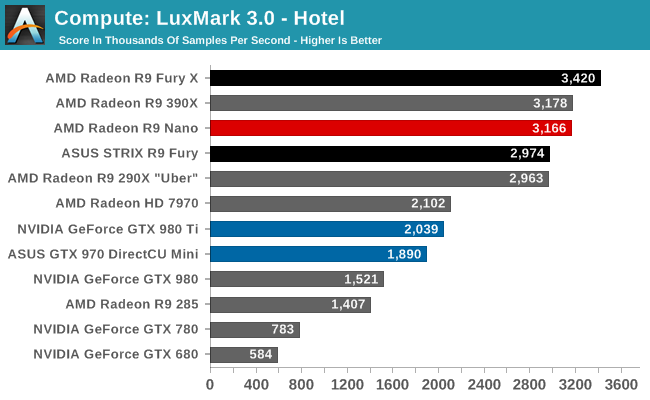
LuxMark ends up being a great corner case for where having a fully enabled Fiji GPU is more important than having the highest clockspeeds. With the R9 Nano able to flirt with its full 1000MHz clockspeed here, the card is able to pass the R9 Fury here. The only thing stopping it from taking the second-place spot is the R9 390X, as Hawaii still sees strong performance here even with fewer SPs.
For our second set of compute benchmarks we have CompuBench 1.5, the successor to CLBenchmark. CompuBench offers a wide array of different practical compute workloads, and we’ve decided to focus on face detection, optical flow modeling, and particle simulations.
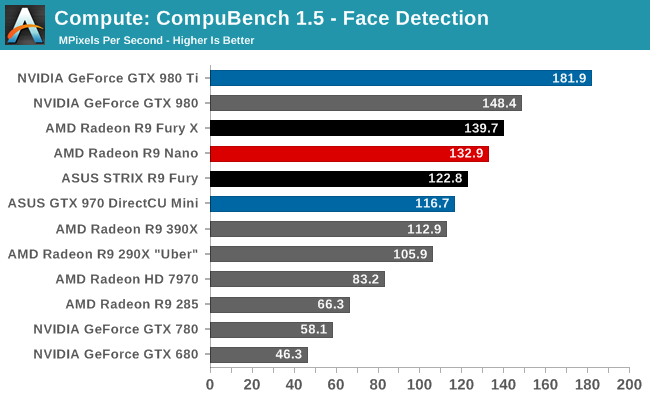
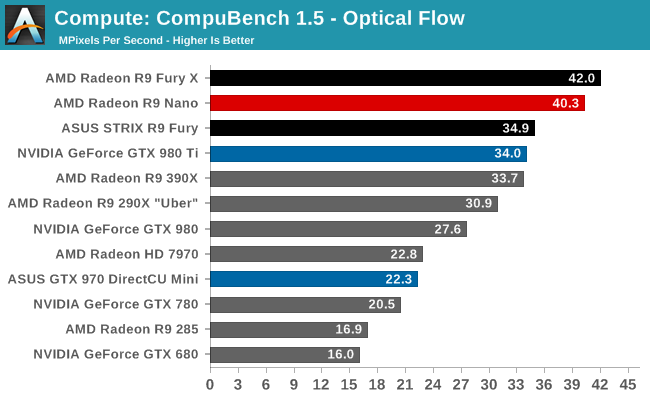
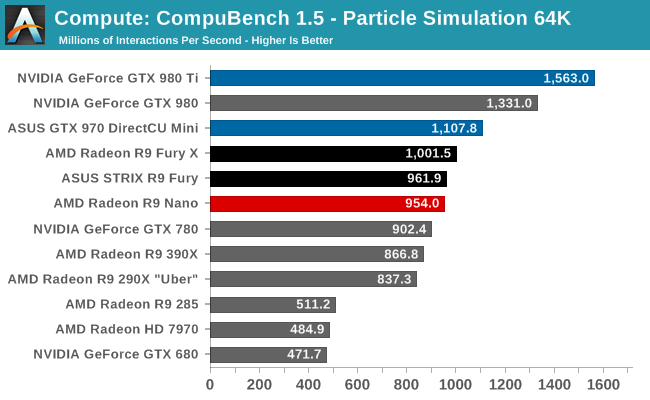
CompuBench provides us another case of where the R9 Nano ends up outpacing the R9 Fury. As a result AMD’s latest card tends to perform somewhere between an R9 Fury and R9 Fury X, with all of the strengths and weaknesses that come from that. This puts the R9 Nano in a good place for Optical Flow, while it will still trail NVIDIA”s best cards under Face Detection and the 64K particle simulation.
Meanwhile it’s interesting to note that AMD’s particle sim scores have significantly improved in the recent drivers. GCN 1.2 cards have seen 20%+ performance improvements here, which may point to some new OpenCL compiler optimizations from AMD.
Our 3rd compute benchmark is Sony Vegas Pro 13, an OpenGL and OpenCL video editing and authoring package. Vegas can use GPUs in a few different ways, the primary uses being to accelerate the video effects and compositing process itself, and in the video encoding step. With video encoding being increasingly offloaded to dedicated DSPs these days we’re focusing on the editing and compositing process, rendering to a low CPU overhead format (XDCAM EX). This specific test comes from Sony, and measures how long it takes to render a video.
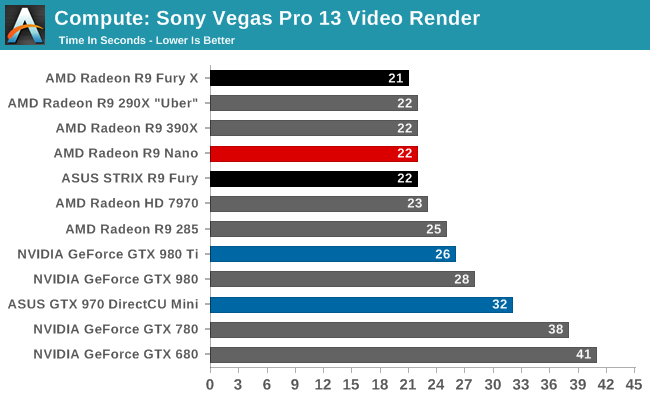
With Vegas there are no surprises; the R9 Nano ties the R9 Fury.
Moving on, our 4th compute benchmark is FAHBench, the official Folding @ Home benchmark. Folding @ Home is the popular Stanford-backed research and distributed computing initiative that has work distributed to millions of volunteer computers over the internet, each of which is responsible for a tiny slice of a protein folding simulation. FAHBench can test both single precision and double precision floating point performance, with single precision being the most useful metric for most consumer cards due to their low double precision performance. Each precision has two modes, explicit and implicit, the difference being whether water atoms are included in the simulation, which adds quite a bit of work and overhead. This is another OpenCL test, utilizing the OpenCL path for FAHCore 17.

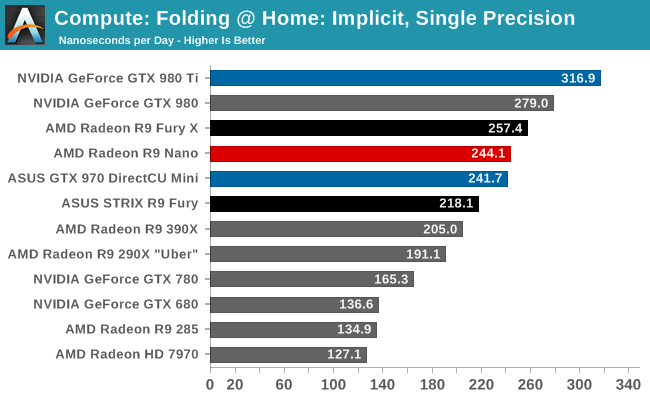
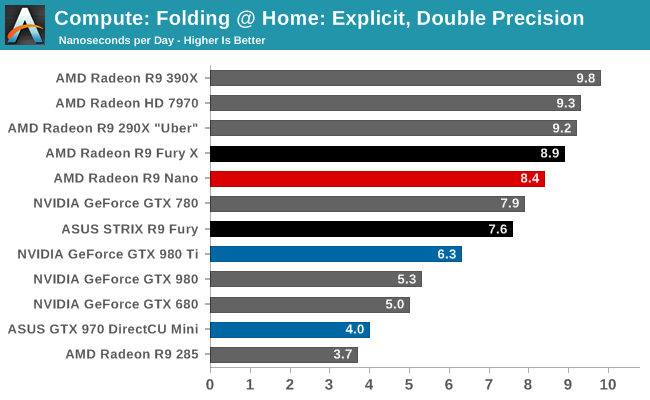
Much like CompuBench and LuxMark, the R9 Nano punches above its weight here. The lack of a graphics workload – and resulting demands on graphics hardware like the ROPs – means most of the card’s power can be allocated to the shaders, allowing higher clockspeeds. This gives the Nano a boost in this situation to bring it much closer to the Fury X, though as far as Folding goes AMD will still trail NVIDIA’s best cards.
Wrapping things up, our final compute benchmark is an in-house project developed by our very own Dr. Ian Cutress. SystemCompute is our first C++ AMP benchmark, utilizing Microsoft’s simple C++ extensions to allow the easy use of GPU computing in C++ programs. SystemCompute in turn is a collection of benchmarks for several different fundamental compute algorithms, with the final score represented in points. DirectCompute is the compute backend for C++ AMP on Windows, so this forms our other DirectCompute test.

Our final test sees the R9 Nano brought back to its place behind the R9 Fury, as the C++ AMP sub-tests are strenuous enough to cause more significant clockspeed throttling. Even behind the R9 Fury the R9 Nano does well for itself here, coming in behind the GTX 980 Ti and head of the R9 390X and GTX 980.










284 Comments
View All Comments
ImSpartacus - Thursday, September 10, 2015 - link
Good to see that Anandtech got a Nano.Wreckage - Thursday, September 10, 2015 - link
I'm sure they agreed to give a "fair" review. I think everyone should wait for independent reviews after the whole Roy Taylor incident.HOOfan 1 - Thursday, September 10, 2015 - link
I bet AMD knew the numbers would be exactly the same at all the big name sites. It is the conclusions they were worried about.close - Thursday, September 10, 2015 - link
Wreckage, you would say that of course after being "motivated" by no less then two 980 graphic cards as gifts just in the last 6 weeks. What kind of credibility do you expect after this?theduckofdeath - Saturday, September 12, 2015 - link
New review on a hardware review site, comment section full of bitching.Yeah, this is the tech news of 2015. Whining and trolling instead of discussing tech.
LoganPowell - Friday, November 27, 2015 - link
It's too bad that the AMD Radeon r9 Nano does so bad among consumer based rankings (see http://www.consumerrunner.com/top-10-best-hard-dri... for example...)theNiZer - Thursday, September 10, 2015 - link
Spot on mate! (sry for double posting)gw74 - Thursday, September 10, 2015 - link
The R9 Nano was about to make me interested in AMD cards finally. On finding out about what they've been up to denying review copies to certain outlets, I am now not interested any more and they are dead to me as a brand.silverblue - Thursday, September 10, 2015 - link
Roy apologised to Scott Wasson and said that he didn't consider The Tech Report as an unfair site, however the reason for their exclusion still hasn't been made known. I suspect he got confused between TechPowerUp and TheTechReport. :)Still, excluding anybody, intentional or otherwise, does your reputation a world of hurt, and starts to provoke questions about those who were included. What a tangled web we weave.
milli - Thursday, September 10, 2015 - link
I don't want to burst your bubble but Scott Wasson has been very pro nVidia for the past ten years. He's just very good at doing it very subliminally, so most won't even notice. As a long time TR reader, it has been pretty obvious to me.